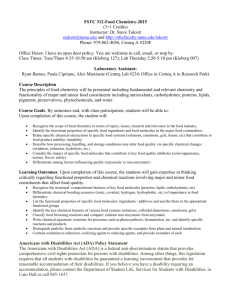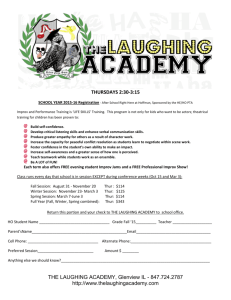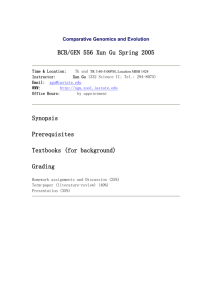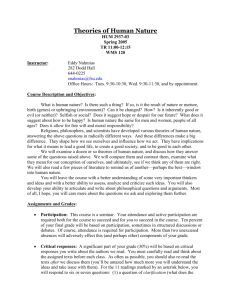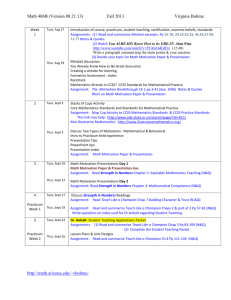syllabus_sex-and-war.. - Harvard Kennedy School
advertisement
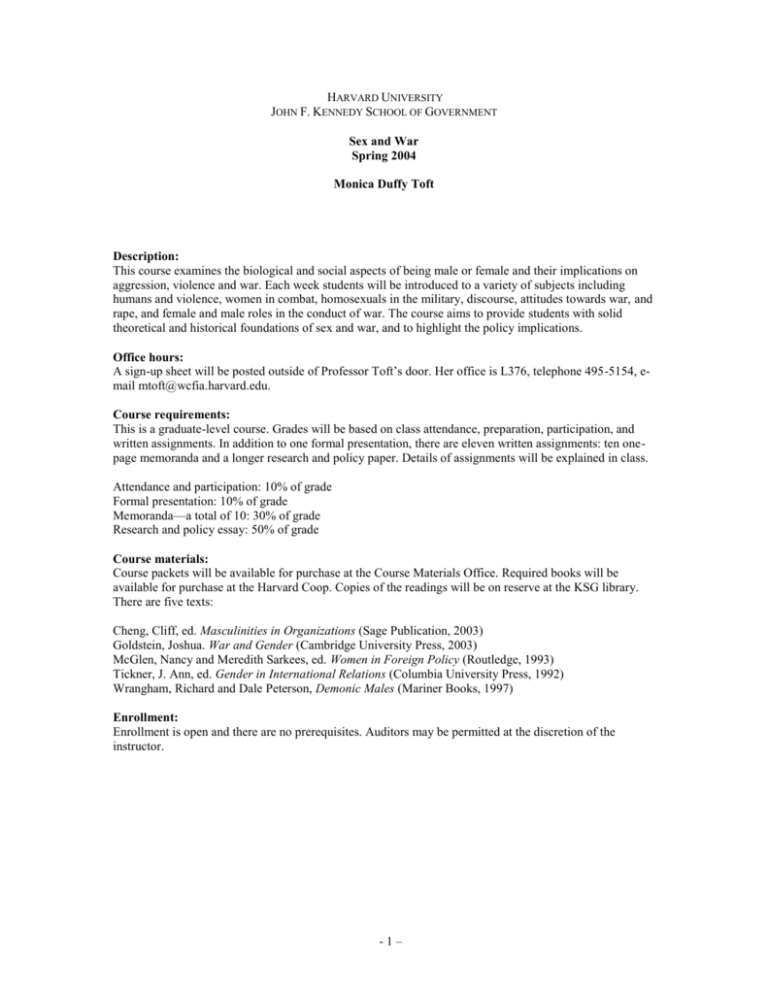
HARVARD UNIVERSITY JOHN F. KENNEDY SCHOOL OF GOVERNMENT Sex and War Spring 2004 Monica Duffy Toft Description: This course examines the biological and social aspects of being male or female and their implications on aggression, violence and war. Each week students will be introduced to a variety of subjects including humans and violence, women in combat, homosexuals in the military, discourse, attitudes towards war, and rape, and female and male roles in the conduct of war. The course aims to provide students with solid theoretical and historical foundations of sex and war, and to highlight the policy implications. Office hours: A sign-up sheet will be posted outside of Professor Toft’s door. Her office is L376, telephone 495-5154, email mtoft@wcfia.harvard.edu. Course requirements: This is a graduate-level course. Grades will be based on class attendance, preparation, participation, and written assignments. In addition to one formal presentation, there are eleven written assignments: ten onepage memoranda and a longer research and policy paper. Details of assignments will be explained in class. Attendance and participation: 10% of grade Formal presentation: 10% of grade Memoranda—a total of 10: 30% of grade Research and policy essay: 50% of grade Course materials: Course packets will be available for purchase at the Course Materials Office. Required books will be available for purchase at the Harvard Coop. Copies of the readings will be on reserve at the KSG library. There are five texts: Cheng, Cliff, ed. Masculinities in Organizations (Sage Publication, 2003) Goldstein, Joshua. War and Gender (Cambridge University Press, 2003) McGlen, Nancy and Meredith Sarkees, ed. Women in Foreign Policy (Routledge, 1993) Tickner, J. Ann, ed. Gender in International Relations (Columbia University Press, 1992) Wrangham, Richard and Dale Peterson, Demonic Males (Mariner Books, 1997) Enrollment: Enrollment is open and there are no prerequisites. Auditors may be permitted at the discretion of the instructor. -1– Overview of course Session Date Subject Assignment 1 2 3 Feb 5 thur Feb 10 tues Feb 12 thur I. Humans and war Overview of the course: sex versus gender The nature of war and killing Humans and violence 1st memo 4 5 6 7 Feb 17 tues Feb 19 thur Feb 24 tues Feb 26 thur II. Nature versus nurture Males and a violence gene? continued Socialization and violence continued 8 9 10 11 12 13 14 15 Mar 2 tues Mar 4 thur Mar 9 tues Mar 11 thur Mar 16 tues Mar 18 thur Mar 23 tues Mar 25 thur Mar 30 tues Apr 1 thur Apr 6 tues Apr 8 thurs III. Roles in warfare Men as killers? continued Women as peacemakers? continued Women in combat continued Homosexuality and military service continued Spring break Spring break Impact of war on women Impact of war on men 21 22 Apr 13 tues Apr 15 thur Apr 20 tues Apr 22 thur Apr 27 tues IV. Discourse and diplomacy Views of diplomacy and war, in the lab Views of diplomacy and war, in the office Opinion on war – gender gap? International relations theory and feminist thought War discourse 23 24 25 Apr 29 thur May 4 tues May 6 thur V. Societal features and war propensity Sex ratios and war Equality and war Wrap-up 16 17 18 19 May 7 Fri Research and policy paper due at noon -2– 2nd memo 3rd memo 4th memo 5th memo 6th memo 7thmemo 8th memo 9th memo 10th memo 11th memo 12th memo 13th memo 14th memo 15th memo 16th memo 17th memo 18th memo 19th memo 20th memo Course Readings Session Date Subject and assigned readings I. Humans and violence 1 Feb 5 thur 2 Feb 10 tues 3 Feb 12 thur Overview of the course: sex versus gender Joshua Goldstein, Gender and War (Cambridge, 2001), chapter 1. Cliff Cheng, ed. Masculinities in Organizations (Sage Publications, 2003), excerpts. The nature of war and killing Robert O’Connell, Of Arms and Men: A History of War, Weapons, and Aggression Cambridge University Press, 1990), excerpts. John Keegan, The Face of Battle (Viking Press, 1995), excerpts. Barbara Ehrenreich Blood Rites: Origins and History of the Passions of War (Henry Holt and Company, 1998), excerpts. Joanna Bourke, An Intimate History of Killing (Basic Books, 2000), excerpts. Humans and violence F. A. Huntingford, “Animals fight, but do not make war” in Aggression and War: Their Biological and Social Bases, eds. Jo Groebel and Robert Hinde (Cambridge University Press, 1989), pp. 25-34. J.H. Goldstein, “Beliefs about Human Aggression” in Aggression and War: Their Biological and Social Bases, eds. Jo Groebel and Robert Hinde (Cambridge University Press, 1989), pp. 10-19. Gabriel, Richard A. "The Biology of War,” In The Culture of War (Greenwood Press, 1990). II. Nature versus nurture 4 Feb 17 tues 5 Feb 19 thur 6 Feb 24 tues 7 Feb 26 thur Males and a violence gene? Richard Wrangham and Dale Peterson, Demonic Males (Mariner, 1997) skim all. continued A. Manning, “The Genetic Basis of Aggression,” in Aggression and War: Their Biological and Social Bases, eds. Jo Groebel and Robert Hinde (Cambridge University Press, 1989), chapter 5. Gat “Female Participation in War: Bio-Cultural Interactions” Journal of Strategic Studies, 2000, pp. 21-31. Barash, “Evolution, Males, and Violence” Chronicle of Higher Education, 2002. Joshua Goldstein, Gender and War (Cambridge, 2001), chapter 3. Socialization and violence Yvette Ahmad and Peter K. Smith, “Bullying in Schools and the Issue of Sex Difference,” ed. John Archer, Male Violence (Routledge, 1994), pp. 7086. John P. Hoffman, Timothy Ireland and Cathy Spatz Widom, “Traditional Socialization Theories: A Critical Examination” in ed. John Archer, Male Violence (Routledge, 1994), pp. 289–311. Joshua Goldstein, Gender and War (Cambridge, 2001), chapter 4. continued David Gillmore, Manhood in the Making (Yale University Press, 1990), chapters 1 and 9. -3– III. Roles in warfare 8 Mar 2 tues 9 Mar 4 thur 10 Mar 9 tues 11 Mar 11 thur 12 Mar 16 tues Men as Killers? Arkin and Dobrofsky, “Military Socialization and Masculinity” Journal of Social Issues, 1978, pp. 151-168. Hartsock “Masculinity, Citizenship, and the Making of War” PS, 1984, pp. 198-202. Klaus Theweleit, Male Fantasies (University of Minnesota Press, 1989), excerpts. Nagel, “Masculinity and nationalism: gender and sexuality in the making of nations” Ethnic and Racial Studies, 1998, pp. 242-269. Barbara Ehrenreich, “Masculinity and American Militarism” Tikkun, 2002 (4pp). continued Winslow, “Rites of Passage and Group Bonding in the Canadian Airborne” Armed Forces and Society, 1999, pp. 429-457. Levy-Schreiber and Ben-Ari, “Body-Building, Character-Building and Nation-Building: Gender and Military Service in Israel” Studies in Contemporary Jewry, 2000, pp. 171-90. Carol Cohn and Cythia Enloe “A Conversation with Cynthia Enloe: Feminists Look at Masculinity and the Men Who Wage War” Signs: Journal of Women in Culture and Society, pp. 1187-1207. Kwon, “A Feminist Exploration of Military Conscription” International Feminist Journal of Politics, 2001, pp. 26-54. Women as Peacemakers? Jean Elshtain, “The Problem with Peace” Millenium, 1988, pp. 441-449. Skjelsbaek “Is Femininity Inherently Peaceful? The Construction of Femininity in War” Gender, Peace, and Conflict, pp. 47-67. Swerdlow, “Motherhood and the Subversion of the Military State: Women Strike for Peace Confronts the House Committee on Un-American Activities” in Women, Militarism and War, eds. Jean Elshtain and Sheila Tobias (Rowman and Littlefield, 1990), pp. 7-31. Scheper-Hughes, “Maternal Thinking and the Politics of War” Peace Review, 1996, pp. 353-358. Joshua Goldstein, Gender and War (Cambridge, 2001), pp. 301–331. continued Nancy McGlen and Meredith Ried Sarkees, “Organizational Factors: Tokens in Diplomacy and War-Making,” in Women in Foreign Policy (Routledge, 1993), chapter 2. York , “The Truth(s) About Women and Peace” Peace Review, 1996, pp. 323-329. Shoemaker, “In War and Peace: Women and Conflict Prevention” Civil Wars, 2002, pp. 7-54. Pankhurst, “The ‘Sex War’ and Other Wars: Towards a Feminist Approach to Peace Building” Development in Practice, 2003, pp. 154-177. Enloe “The Politics of Constructing the American Woman Soldier” in Addis, Russo, Sebesta Women Soldiers: Images and Realities, 1994, pp. 81-110. Women in combat Joshua Goldstein, Gender and War (Cambridge, 2001), chapter 2. Tuten and Segal in Female Soldiers: Combatants or Noncombatants?, 1982, pp. 237-290. Jones, “Dividing the Ranks; Women and the Draft” in Women, Militarism and War, eds Jean Elshtain and Sheila Tobias (Rowman and Littlefield, 1990), pp. 125-140. Laura Miller “Feminism and the Exclusion of Army Women from Combat.” -4– 13 Mar 18 thur 14 Mar 23 tues Olin Institute paper, 1995, 36 p. Segal “Women’s Military Roles Cross-Nationally: Past, Present, and Future.” Gender and Society, 1995, pp. 757-775. continued Moskos 1998 “The Folly of Comparing Race and Gender in the Army” The Washington Post. Nantais and Lee, “Women in the United States Military: protectors or protected? The case of prisoner of war Melissa Rathbun-Nealy” Journal of Gender Studies, 1999, pp. 181-191. DEBATE: Van Creveld “The Great Illusion: Women in the Military”/ Elshtain’s response / Coker’s response. Journal of International Studies, 2000, pp. 429-460. Stephanie Gutmann, The Kinder, Gentler Military:Can America’s GenderNeutral Fighting Force Still Win Wars? (Scribner 2000), excerpts. Boulègue, “’Feminization’ and the French Military: An Anthropological Approach’” Armed Forces and Society, 1991, pp. 343-362. Vojdik, “The Invisibility of Gender in War.” Duke Journal of Gender Law and Policy, 2002, pp. 261-270. El-Bushra “Fused in combat: gender relations and armed conflict” Development in Practice, 2003, pp. 252-265. Nuciari “Women in the Military: Sociological Arguments for Integration” in Handbook of the Sociology of the Military, 2003, pp. 279-297. Gerard DeGroot “A Few Good Women: Gender Stereotypes, the Military and Peacekeeping,” International Peacekeeing, Vol. 8, No. 2 (Summer 2001), pp. 23–38. Rosen et al. “Gender Composition and Group Cohesion in U.S. Army Units: A Comparison across Five Studies” Armed Forces and Society, pp. 365386. Titunik “The First Wave: Gender Integration and Military Culture.” Armed Forces and Society, 2000, pp. 229-257. Laura Miller and Charles Moskos “Humanitarians or Warriors?: Race, Gender, and Combat Status in Operation Restore Hope” Armed Forces and Society, pp. 615-635. Kristof op-ed 25 April 2003 New York Times. O’Beirne “An Army of Jessicas: About women in combat: Let’s Fight. Hard.” National Review, 2003, pp. 40-41. Homosexuality and military service Adair and Myers “Admission of Gays to the Military: A Singularly Intolerant Act.” Parameters, 1993, pp. 10-19. Colonel Ray “Lifting the Ban on Homosexuals in the Military: The Subversion of a Moral Principle” in eds. Scott and Stanley, Gays and Lesbians in the Military, 1994, pp. 87-101. Lehring “Constructing the ‘Other’ Soldier:” Gay Identity’s Military Threat” in Gay Rights, Military Wrongs: Political Perspectives on Lesbians and Gays in the Military, ed. Rimmerman, pp. 269-292. Laura Miller “Fighting for a Just Cause: Soldiers’ Views on Gays in the Military” in Scott and Stanley, 1994 Gays and Lesbians in the Military, pp. 69-85. Sarbin “The Deconstruction of Stereotypes: Homosexuals and Military Policy” in Out in Force: Sexual Orientation and the Military, eds Herek, Jobe, Carney, 1996, pp. 177-196. Carol Cohn, “Gays in the Military: Texts and Subtexts” in The ‘Man’ Question in International Relations, eds Zalewski and Parpart, 1998, pp. 129-149. Elizabeth Kier, “Homosexuals in the U.S. Military: Open Integration and Combat Effectiveness.” International Security, 1998, pp. 5-39. -5– 15 Mar 25 thur 16 Mar 30 tues Apr 1 thur Apr 6 tues 17 Apr 8 thurs Aaron Belkin et al. “A Modest Proposal: Privacy as a Flawed Rationale for the Exclusion of Gays and Lesbians from the U.S. Military” International Security, 2002, pp. 178-197. continued Report to the Secretary of Defense “Review of the Effectiveness of the Application and Enforcement of the Department’s Policy on Homosexual Conduct in the Military” April 1998, excerpts. RAND report on Homosexuality in the U.S. Military, 1993, excerpts. UK Ministry of Defence Report on Homosexuality in the Military, 1996, excerpts. Harries-Jenkins and Dandeker “Sexual Orientation and Military Service: The British Case” in Scott and Stanley 1994 Gays and Lesbians in the Military: 191-204. Gade, Segal, Johnson “The Experience of Foreign Militaries” in Out in Force: Sexual Orientation and the Military, eds Herek, Jobe, Carney, 1996, pp. 106-130 Thomas and Thomas “Integration of Women in the Military: Parallels to the Progress of Homosexuals?” in Out in Force: Sexual Orientation and the Military, eds Herek, Jobe, Carney, 1996, pp. 65-85. Spring break Spring break Impact of war on women Brittain “The impact of war on women” Race and Class, 2003, pp. 41-51. Joshua Goldstein, Gender and War (Cambridge, 2001), pp. 380–401. Skjelsbaek, “Sexual Violence and War: Mapping Out a Complex Relationship.” European Journal of International Relations, 2001, pp. 211-237. Benard “Rape as Terror: The Case of Bosnia” Terrorism and Political Violence, 1994, pp. 29-43. Cynthia Enloe, “Spoils of War” Ms, 1996, pp. Littlewood “Military Rape” Anthropology Today, 1997, pp. 7-16. Sharlach, “Rape as Genocide: Bangladesh, the Former Yugoslavia, and Rwanda.” New Political Science, 2000, pp. 89-102.Turshen “The Political Economy of Rape: An Analysis of Systematic Rape and Sexual Abuse of Women during Armed Conflict in Africa” in eds. Caroline Moser and Fiona Clark Victims, Perpetrators or Actors? (Zed Books, 2001), pp. 55-68. Chelala “Algerian Abortion Controversy Highlights Rape of War Victims” The Lancet. Mike Kesby, “Arenas for Control, Terrains of Gender of Contestation: Guerrilla Struggle and Counter-Insurgency Warfare in Zimbabwe, 1972– 1980, Journal of South African Studies, Vol. 22, No. 4 (December 1996), pp. 561–584. Impact of war on men Enda Lomsky-Feder, “The Meaning of War through Veterans’ Eyes,” International Sociology, Vol. 10, No. 4 (December 1995), pp. 463–482. Dave Grossman, On Killing (Little Brown and Company, 1996), excerpts. Selected Poetry from WWI. Karner “Engendering Violent Men: Oral Histories of Military Masculinity” in Masculinities and Violence, ed. Bowker, 1998, pp. 197-232. Hallock “The Change is Forever” in Hell, Healing and Resistance: Veterans Speak, 1998. -6– IV. Discourse and diplomacy 18 Apr 13 tues 19 Apr 15 thur Apr 20 tues 21 Apr 22 thur 22 Apr 27 tues Views of diplomacy and war, in the lab Rose McDermott and Jonathan Cowden, The Effects of Uncertainty and Sex in a Crisis Simulation Game, International Interactions, Vol. 27 (2001), pp. 353-380. Beer et al. “Peace Agreement, Intractable Conflict, Escalation Trajectory: A Psychologial Laboratory Experiment” International Studies Quarterly, 1995, pp. 297-312. Views of diplomacy and war, in the office DEBATE Francis Fukuyama “Women and the Evolution of World Politics”/Barbara Ehrenreich’s “So What?”/Pollitt’s response/Ferguson’s response/Jaquette’s response Foreign Affairs, 1998, pp. 24-40 and 118129. J. Ann Ticknr’s response in International Studies Quarterly, 1998, pp. 3-11. Nancy McGlen and Meredith Ried Sarkees, “Gender Gap in Management Styles?,” in Women in Foreign Policy (Routledge, 1993), chapter 6. Opinion on war – gender gap? Conover and Sapiro “Gender, Feminist Consciousness, and War” American Journal of Political Science, 1993, pp. 1079-1099. Holsti and Rosenau “Gender and the Political Beliefs of American Political Leaders” in Women in World Politics: An Introduction, eds D’Amico and Beckman, 1995, pp. 113-141. Bendyna et al “Gender Differences in Public Attitudes Toward the Gulf War: A Test of Competing Hypotheses” The Social Science Journal, 1996, pp. 1-22. Wilcox, Hewitt, Allsop “The Gender Gap in Attitudes Toward the Gulf War: A Cross-National Perspective” Journal of Peace Research, 1996, pp. 6782. Tessler and Warriner, “Gender, Feminism, and Attitudes Toward International Conflict: Exploring Relationships with Survey Data from the Middle East” World Politics, 1997, pp. 250-281. Nincic and Nincic “Race, Gender, and War” Journal of Peace Research, 2002, pp. 547-568. International relations theory and feminist thought J. Ann Tickner, ed. Gender in International Relations, selected chapters. Craig Murphy “Seeing Women, Recognizing Gender, Recasting International Relations” International Organization, Vol. 50, No. 3 (Summer 1996), pp. 513-538. DEBATE J. Ann Tickner, “You Just Don’t Understand: Troubled Engagements Between Feminists and IR Theorists” / Keohane’s response / Marchand’s response / Tickner again. International Studies Quarterly, 1997, pp. 611-632, 193-210. Charli Carpenter “Gender Theory in World Politics: Contributions of a Nonfeminist Standpoint?” International Studies Quarterly, 2002, pp. 153-165. J. Ann Tickner, “Feminist Perspectives on 9/11” International Studies Perspectives, 2002, pp. 333-350. War discourse: sex and games Carol Cohn, “Sex and Death in the Rational World of Defense Intellectuals” Signs: Journal of Women in Culture and Society, 1987. Ben-Ari E. “Mask and Soldiering: The Israeli Army and the Palestinians Uprising,” Vol. 4, No. 4, Cultural Anthropology, pp, 372-389. McBride “America’s War in the Gulf: Phallic and Castration Imagery in the Rhetoric of Combat” in War, Battering, and other Sports: The Gulf -7– Between American Men and Women, 1995, pp. 35-76. Niva “Tough and Tender: New World Order Masculinity and the Gulf War” in The ‘Man’ Question in International Relations, eds Zalewski and Parpart, 1998, pp. 109-127. V. Societal features and war propensity 23 Apr 29 thur 24 May 4 tues 25 May 6 thur Sex ratios and war Divale, "An explanation for primitive warfare: population control and the significance of primitive sex ratios" The New Scholar (Fall 1970), pp. 173-192. Victoria Hudson and Den Boer, “A Surplus of Men, A Deficit of Peace: Security and Sex Ratio in Asia’s Largest States” International Security, 2002, pp. 5-38. Equality and war Mary Caprioli, “Gendered Conflict” Journal of Peace Research, 2000, pp. 53-68. Mary Caprioli and Mark Boyer “Gender, Violence, and International Crisis” Journal of Conflict Resolution, Vol. 45, No. 4 (August 2001), pp. 503518. Patrick Regan and Paskeviciute “Women’s Access to Politics and Peaceful States” Journal of Peace Research, 2003, pp. 287-302. Wrap-up -8–


